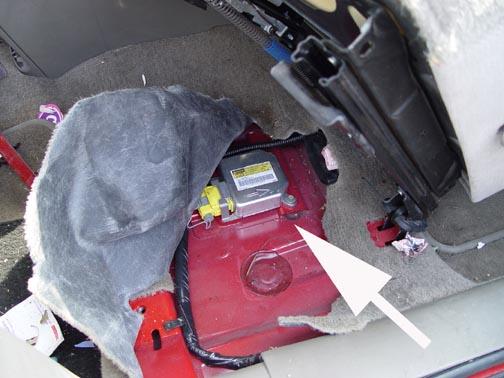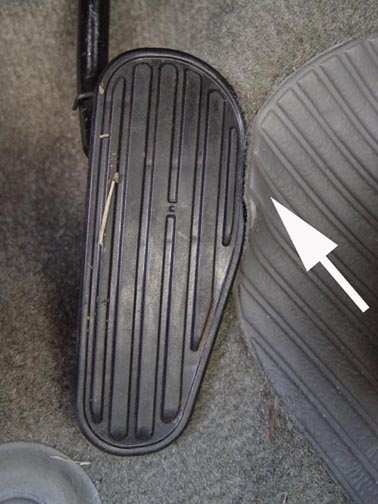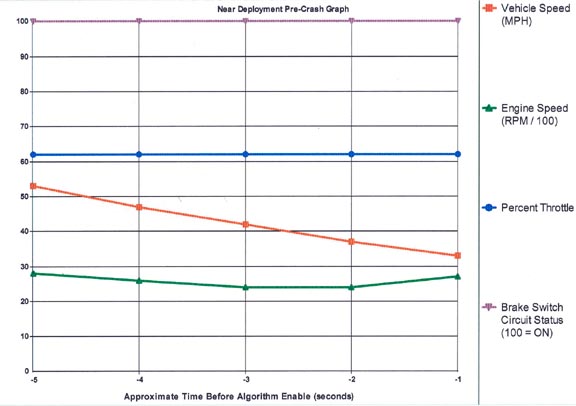
Figure 1
The data in the black box on about 30 percent of the
vehicles on the road can be downloaded onto a
laptop and used as evidence in subrogation related
actions. As an example, take the “stuck throttle”
claim depicted in Figure 2. The insured claimed that
the accelerator stuck and that he had difficulty
controlling the vehicle, causing an accident.
Inspection of the vehicle showed that the
accelerator pedal may have engaged the carpet,
causing it to stay about 50% depressed as shown in
Figure 2. The pedal can catch in the plastic wear
guard, leading one to conclude that either a
defective design of the carpet or defective
installation exists.

Figure 2

Figure 3
Figure 3 is the download from the black box in
graphical form. The horizontal axis shows seconds
before impact. The vertical axis graphs vehicle
speed (MPH), engine speed (RPM/100), percent
throttle opening and brake switch status (brake on
or off). At 5 seconds before impact, the brake
switch is 100 = ON, indicating the brake pedal has
been pressed. The throttle position is 62% open.
The vehicle speed is 53 MPH and the engine RPM
is about 2800. At one second before impact, the
brake switch is 100 = ON, indicating the brake
pedal continues to be pressed. The throttle position
is 62% open. The vehicle speed is 32 MPH and the
engine RPM is about 2700. Since the brake is
pressed, the driver’s foot is not on the accelerator,
and the engine speed should quickly drop to idle or
about 800 RPM. In this case, the throttle stays about
62% open, which tends to substantiate the claim
that the accelerator pedal stuck. Figure 4 shows
additional data from the download, which indicates
that the driver was not wearing his seat belt.

Figure 4
Black box data is a form of evidence that could be
influential in subrogation and at trial. The consensus
among legal scholars is that black box data is the
property of the vehicle owner. As always,
permission from the insured or a court order is
necessary to download the data. It should be noted
that some data is time dependent and after a certain
number of ignition cycles is erased.
Black box data is expected to revolutionize
automobile accident reconstruction, rendering speed
and velocity change calculations obsolete is certain
cases. Although not all black box data is readily
available, more vehicles will be equipped with
accessible memory as time goes on. Currently,
software is available to access the black box data on
about 30% of the vehicles on the road. Availability
of favorable black box data at trial can form a
credible basis for legal arguments as to why a
particular party should prevail.
1. “Claims Issues and the Supplemental Individual
Restrain System,” Claims Magazine, December 2003, pp 30-32.
2. “Inside the Mind of a New Car,” Claims
Magazine, June 1994, pp 36-44.
3. “Computer Fault Codes Interest Investigators,”
Claims Magazine, March 1989, pp 91-92.
BACK TO C. ROBERTS CONSULTING ENGINEERS HOME PAGE,
WWW.CROBERTS.COM

Figure 2

Figure 3
Figure 3 is the download from the black box in
graphical form. The horizontal axis shows seconds
before impact. The vertical axis graphs vehicle
speed (MPH), engine speed (RPM/100), percent
throttle opening and brake switch status (brake on
or off). At 5 seconds before impact, the brake
switch is 100 = ON, indicating the brake pedal has
been pressed. The throttle position is 62% open.
The vehicle speed is 53 MPH and the engine RPM
is about 2800. At one second before impact, the
brake switch is 100 = ON, indicating the brake
pedal continues to be pressed. The throttle position
is 62% open. The vehicle speed is 32 MPH and the
engine RPM is about 2700. Since the brake is
pressed, the driver’s foot is not on the accelerator,
and the engine speed should quickly drop to idle or
about 800 RPM. In this case, the throttle stays about
62% open, which tends to substantiate the claim
that the accelerator pedal stuck. Figure 4 shows
additional data from the download, which indicates
that the driver was not wearing his seat belt.

Figure 4
Black box data is a form of evidence that could be
influential in subrogation and at trial. The consensus
among legal scholars is that black box data is the
property of the vehicle owner. As always,
permission from the insured or a court order is
necessary to download the data. It should be noted
that some data is time dependent and after a certain
number of ignition cycles is erased.
Black box data is expected to revolutionize
automobile accident reconstruction, rendering speed
and velocity change calculations obsolete is certain
cases. Although not all black box data is readily
available, more vehicles will be equipped with
accessible memory as time goes on. Currently,
software is available to access the black box data on
about 30% of the vehicles on the road. Availability
of favorable black box data at trial can form a
credible basis for legal arguments as to why a
particular party should prevail.
1. “Claims Issues and the Supplemental Individual
Restrain System,” Claims Magazine, December 2003, pp 30-32.
2. “Inside the Mind of a New Car,” Claims
Magazine, June 1994, pp 36-44.
3. “Computer Fault Codes Interest Investigators,”
Claims Magazine, March 1989, pp 91-92.
BACK TO C. ROBERTS CONSULTING ENGINEERS HOME PAGE,
WWW.CROBERTS.COM

Figure 4
Black box data is a form of evidence that could be influential in subrogation and at trial. The consensus among legal scholars is that black box data is the property of the vehicle owner. As always, permission from the insured or a court order is necessary to download the data. It should be noted that some data is time dependent and after a certain number of ignition cycles is erased.
Black box data is expected to revolutionize automobile accident reconstruction, rendering speed and velocity change calculations obsolete is certain cases. Although not all black box data is readily available, more vehicles will be equipped with accessible memory as time goes on. Currently, software is available to access the black box data on about 30% of the vehicles on the road. Availability of favorable black box data at trial can form a credible basis for legal arguments as to why a particular party should prevail.
1. “Claims Issues and the Supplemental Individual Restrain System,” Claims Magazine, December 2003, pp 30-32.
2. “Inside the Mind of a New Car,” Claims Magazine, June 1994, pp 36-44.
3. “Computer Fault Codes Interest Investigators,” Claims Magazine, March 1989, pp 91-92.
BACK TO C. ROBERTS CONSULTING ENGINEERS HOME PAGE,
WWW.CROBERTS.COM
WWW.CROBERTS.COM